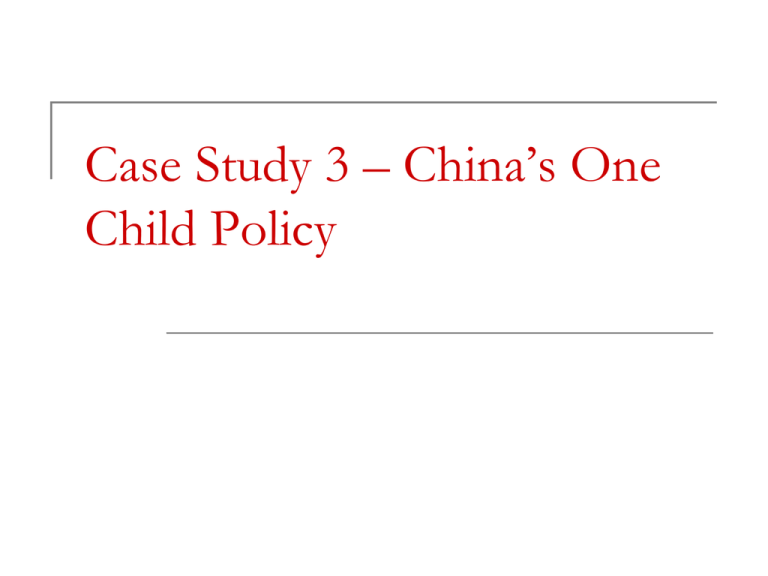
Case Study 3 – China’s One
Child Policy
Chinese Demographics
More people live in China than the combined population of:
Any population change in China has global impact:
1980s: About 14-17 million people were added each year
1990s: Average of 13 million people were added each year
2000s: 10 million people per year
Towns and Cities
Europe
North America
South America
Japan
400 million live in cites
30-35% of the population (58% in the US live in cities)
rural (countryside) areas
950 million live in the countryside
64% of the population (42% in the US live outside of large cities)
The Population of China
0-2050 AD
1600
1.6 Billion
2050
1.4 Billion
1400
2000
1995
1.2 Billion
1200
1 Billion
1000
1981
800
1970
800 million
600 million
600
1953
1949
400 million
1851
1911
18121887
400
200 million
200
0
2
105
0
755
500
1210
1083
1000
1381
1562 1650
1500
1753
2000
Chinese Population, 1949-2000
(projections to 2050)
1500
1.5 billion
1300
1.3 billion
1.1 billion
1100
900 million
900
700
700 million
500
500 million
1945
1955
1965
1975
1985
1995
2005
2015
2025
2035
2045
Population of Selected Chinese
Provinces, 1998
France
KEY
United Kingdom
Grey Bars- Foreign countries
Red Bars- Chinese states
Italy
Egypt
Hunan
Hebei
Iran
Philippines
Jiangsu
Germany
Shandong
Henan
Mexico
Nigeria
.
Sichuan
0
20
40
60
80
100
120
Chinese Demographics
1.
2.
3.
4.
Problems with controlling
population growth:
The population grew very
quickly after 1949.
Population control was not
seen as important as
setting up a communist
government.
Mao Zedong saw
population growth as a
good way to fight the
Soviet Union and the
United States.
The Communists called on
women to “breed for the
motherland”.
One Child Policy propaganda
poster
Chinese Demographics
Population distribution
Excessive concentration in
the eastern part of China
50% of the population lives
on 8.2% of the land.
Bulk of the population lives
along the coast.
East China accounts for
90% of the population.
56%, about 728 million, are
living in mountainous areas.
The majority of Chinese live in
the area that is circled in the
East.
Chinese Demographics
1990 and 2000 Census
1990
Counted 1.134 billion Chinese
in China.
Population was moving to the
cities
The percentage of urban (city)
population had increased from
20.6% in 1982 to 26.2% by
1990.
An increase of 5.6% in just
eight years.
Why did so many people move
to the cities?
Jobs
Greater opportunity
Government’s departure from
socialist methods of production
in the secondary sector.
Results of the 2000
census
Go to:
http://www.google.com/p
ublicdata?ds=wbwdi&met=sp_pop_totl&idi
m=country:CHN&q=china
+population+statistics
Chinese Demographics
Current issues
Population growth hurts Chinese development in:
Acceleration of urbanization at the expense of
farmland
Education
Health
Transportation
loss of 10% of China’s farmland since 1978
About 10 million people reach the employment market
each year.
Acres of Farmland per Person
1.66
US
0.67
Nigeria
2.05
0.96
0.22
0.3
Indonesia
India
0.42
0.59
0.35
0.37
Germany
0.82
0.79
Brazil
1994-1996
1979-1981
0.2
0.25
China
0
0.5
1
1.5
2
2.5
Family Planning Prior to the
One Child Policy
Early 1970s: “later-longer-fewer program”.
Age of marriage
Reasoning?
25 for men
23 for women
Wait later to begin their families
allow for longer spacing in between children
have fewer children overall.
Began to reduce fertility levels.
Problem? Not fast enough to really slow down population growth due
to the momentum that had already developed.
End of 1970s: “One is best, at most two, never a third”
Government began to promote the two-child family throughout the
country.
Problem? Slogan Contributed to fertility decline but, again, not
rapidly enough.
One Child Policy
Launched in 1981 when the population
reached 1 billion.
Initial goal: Stabilize China’s
population at 1.2 billion.
Revised goal: Keep China’s population
under 1.4 billion until 2010.
Population expected to stabilize
around 1.6 billion by 2050.
Under the responsibility of the State
Family Planning Commission (SFPC).
Great variations in performance
between the country’s urban and rural
areas.
Easier to enforce in China because it
was a totalitarian state
Would have been impossible in most
other places.
One Child Policy propaganda
poster
Family Planning
Regulations of the policy
Employers and neighborhood committees had to enforce
guidelines.
1) Young people needed permission to get married:
2) The government monitored women’s menstrual cycles.
3) The use of birth control was required by the government:
25 years for male and 23 years for female.
Students and apprentices are not allowed to marry until they finish
their studies.
UID used for women with already one child.
Incentives for sterilization after the birth of the first child.
Couples with two or more children had to have one partner sterilized
(women 80% of the time).
4) All pregnancies must be authorized:
Unauthorized pregnancies had to be aborted.
7th, 8th or 9th month abortions are legal.
Family Planning
Incentives offered to couples with only one child:
Monthly allowances paid to couples with only one child.
Child entitled to free educational and medical services.
Disincentives (penalties) used to discourage larger families:
Fine up to 15% of annual income.
Couples forced to give up all privileges if a second child was
born and had to repay any cash awards it had received.
A third child denied free education, subsidized food, and
housing privileges.
A third child’s parents would be penalized with a 10%
reduction in wages.
Family Planning
Urban areas or cities
Small sized apartments.
Improving one’s status and level of consumption.
Easier control from the government.
Rural areas or the countryside
Families want more children to work the family plots and
support their parents when they get old.
Want sons who will continue the family line and provide
ritual sacrifices to their ancestors after they die.
Daughters are leaving their family once they marry.
Girls account for only 20 to 30% of a new demographic
class in some areas.
Percentage of Women Having More
Than One Child, 1998
Xinjiang
21.55
The One Child Policy has:
26.58
Tibet
Sichuan
4.19
12.32
Guangdong
Fujian
3.68
Jiangsu
2.16
Shanghai
0
Beijing
0.19
National
5.1
0
10
20
30
Prevented about 300 million
births since 1980.
When the program began
(1970), Crude Birth Rate
was 34 and TFR was
around 6.
Been brought down to 10
(CBR) and 1.7 (TFR).
About 40% of Chinese
women have been
sterilized.
Only about 5% of women
have more than one child.
Chinese Fertility Rate, 1949-1998
(TFR means the # of Children Born per Woman)
40
7
TFR
Natural Increase
6
4
3
2
30
25
20
15
10
5
0
1
-5
0
-10
19
49
19
52
19
55
19
58
19
61
19
64
19
67
19
70
19
73
19
76
19
79
19
82
19
85
19
88
19
91
19
94
19
97
TFR
5
35
Natural Increase
8
Family Planning
Imbalanced sex ratio
Male children are more valued.
120 boys for 100 girls (national average).
Abandon or abortion of females.
“Missing female population” as girls are not declared.
2000: About 900,000 girls were missing (0 to 4 years group).
Only 1% of females are unmarried by the age of 30.
Psychological consequences:
Currently around 70 million single child.
4-2-1 syndrome (4 grand parents – 2 parents – 1 child):
“Little emperors” or “little empresses”.
Self-centrism.
Pressure to succeed.
Family Planning
A new family planning law
started in 2002.
Same goal than the One-child
policy, but offer more flexibility:
One child, but permission may be
granted for a second under specific
circumstances.
Late marriage and childbearing.
More flexibility for provinces,
autonomous regions and
minorities.
People in reproductive age have to
use contraception (birth control).
Provisions for sex-determination
and sex-specific abortions.
Population Planning in China
What would have happened if the One Child Policy
was not applied?
Population by 2000 would have reached 1.6 billion (instead
of 1.3).
Annual increase would be 40 million (instead of 17-19).
Require much higher level of economic development.
The total population will continue to increase
Even if the natural growth rate can be lowered to 1% by
2005.
Annual increase of population will still be more than 10
million.
This trend would continue to increase in the next 50 years.
Even with effective family planning, China’s population will not
stabilize until it reaches 1.5-1.6 billion by 2050.
Population Planning in China
Improve the quality of the population
Education and health.
2.5 million students entered Universities in 2001.
Tremendous incurred costs.
Potential surplus labor in rural areas (countryside)
2 Causes?
development of the rural economy
higher rate of birth.
Large numbers of surplus (extra) rural labor who will need
to transfer from the agricultural to a non-agricultural field.
Speed urbanization of the population and create bigger
pressure on cities and towns.
Population Planning in China
Aging of the population
Persons 65 years and older represent about 7
percent of the population.
In the 21st century, China’s population will
continue this aging trend.
65 years old or older numbering 250 million by the
year 2040.
Providing social security and services to a huge
elderly population.






